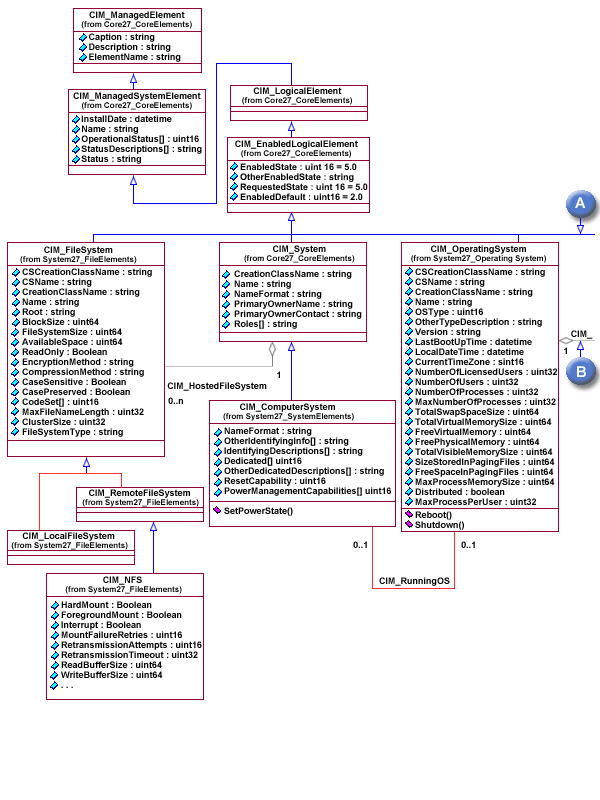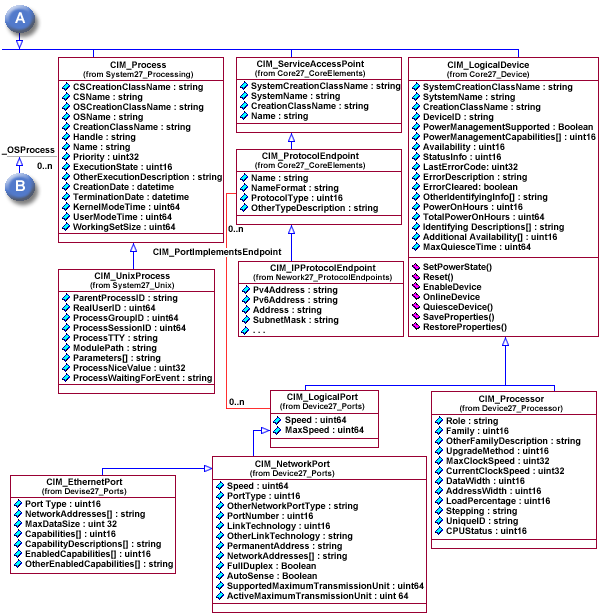IBM® has implemented CIM classes as IBM-supplied providers to provide basic operating system information.
The providers supplied by IBM are as follows:
- IBMOS400_ComputerSystem: subclass of CIM_Computer_System
- IBMOS400_OperatingSystem: subclass of CIM_OperatingSystem
- IBMOS400_RunningOS: subclass of CIM_RunningOS
- IBMOS400_Process: subclass of CIM_Process
- IBMOS400_OSProcess: subclass of CIM_OSProcess
 IBMOS400_VirtualProcessor: subclass of CIM_Processor
IBMOS400_VirtualProcessor: subclass of CIM_Processor
 IBM_IPProtocolEndpoint: a subclass of CIM_IPProtocolEndpoint
IBM_IPProtocolEndpoint: a subclass of CIM_IPProtocolEndpoint
 IBM_LocalFileSystem: a subclass of CIM_LocalFileSystem
IBM_LocalFileSystem: a subclass of CIM_LocalFileSystem
 IBM_RemoteFileSystem: a subclass of CIM_RemoteFileSystem
IBM_RemoteFileSystem: a subclass of CIM_RemoteFileSystem 
 IBM_NFS: a subclass of CIM_NFS
IBM_NFS: a subclass of CIM_NFS
 IBMOS400_NetworkPort: a subclass of CIM_NetworkPort
IBMOS400_NetworkPort: a subclass of CIM_NetworkPort
 IBM_EthernetPort: a subclass of CIM_EthernetPort
IBM_EthernetPort: a subclass of CIM_EthernetPort
 IBM_TokenRingPort: a subclass of CIM_TokenRingPort
IBM_TokenRingPort: a subclass of CIM_TokenRingPort
 IBMOS400_CSVirtualProcessor: a subclass of CIM_SystemDevice
IBMOS400_CSVirtualProcessor: a subclass of CIM_SystemDevice
 IBM_CSNetworkPort: a subclass of CIM_SystemDevice
IBM_CSNetworkPort: a subclass of CIM_SystemDevice
 IBMOS400_HostedFileSystem: a subclass of CIM_HostedFileSystem
IBMOS400_HostedFileSystem: a subclass of CIM_HostedFileSystem 
 IBM_BootOSFromFS: a subclass of CIM_BootOSFromFS
IBM_BootOSFromFS: a subclass of CIM_BootOSFromFS 
 IBM_NWPortImplementsIPEndpoint: a subclass of CIM_PortImplementsEndpoint
IBM_NWPortImplementsIPEndpoint: a subclass of CIM_PortImplementsEndpoint
Some property values are available in several languages to CIM clients that follow the globalization interface as described in the DMTF standards.
The following figure shows the CIM base classes that are extended by the IBM extension classes.


The managed object format (MOF) files that define these classes can be found in the /QIBM/ProdData/OS400/CIM/Schemas/OS400/ directory. The file names are as follows:
- IBMOS400_OSBase.mof
- IBMOS400_BootOSFromFS.mof
- IBMOS400_CSNetworkPort.mof
- IBMOS400_CSVirtualProcessor.mof
- IBMOS400_FileSystem.mof
- IBMOS400_HostedFileSystem.mof
- IBMOS400_NWPortImplementsIPEndpoint.mof
- IBMOS400_NetworkPort.mof
- IBMOS400_ProtocolEndpoints.mof
- IBMOS400_VirtualProcessor.mof
IBMOS400_ComputerSystem
This class makes available basic computer system information such as computer name, and status information. This provider instrumenting this class is for use by clients as part of a basic understanding of the identity of the managed system on which it is running (typically a server or appliance).
The following properties have data that can be specific to i5/OS™, or can map to i5/OS system-specific attributes.
| Property | Property value and data source |
|---|---|
| string OtherIdentifyingInfo[] | Returns the system:
|
| Name | The system name based on the first entry in the TCP/IP host table. |
IBMOS400_OperatingSystem
This class is for use by clients as part of a basic understanding of the identity of the Managed System on which the corresponding provider is running (typically a server or appliance).
The following properties have data that may be specific to i5/OS, or may map to i5/OS specific attributes.
| Property | Property value and data source |
|---|---|
| uint32 NumberOfUsers | The number of interactive jobs on the system |
| uint32 NumberOfProcesses | The total number of user jobs and system jobs that are currently in the system. The total includes:
|
| uint32 MaxNumberOfProcesses | The maximum number of jobs that are allowed on the system. |
| string LanguageEdition | Returns QLANGID system value. |
| string CodeSet (maximum length is 64) | Returns code page field from QCHRID system value. |
| uint32 DefaultPageSize (in bytes) | Always returns 4096. |
 For the IBMOS400_OperatingSystem class, the Shutdown()
and Reboot() methods are implemented in V5R4.
For the IBMOS400_OperatingSystem class, the Shutdown()
and Reboot() methods are implemented in V5R4.
IBMOS400_RunningOS
This provider for this class is for use by clients to find associations between a computer system and the operating system that is currently running on the computer system.
IBMOS400_Process
The provider for this class makes available basic process information such as process name (a fully qualified job name on i5/OS), priority, runtime state. An IBMOS400_Process is mapped to i5/OS jobs on the iSeries™ server. Client applications can use this provider to give clients an understanding of the processes (jobs) running on the managed system within the context of its operating system.
The following properties have data that can be specific to i5/OS, or can map to i5/OS specific attributes.
| Property | Property value and data source | |
|---|---|---|
| string ElementName | Returns string from the Name field below - the fully-qualified job name on i5/OS as viewed on command-line interface. | |
| string Name | This is the fully-qualified job name on i5/OS as viewed on the command-line
interface: Job number field + / + User name field + / + Job name field where Job number is the system-generated job number. User name is the user name of the job, which is the same as the name of the user profile under which the job was started. Job name is the name of the job as identified to the system. |
|
| string Handle [Key] | This is the fully-qualified job name on the i5/OS as used in the i5/OS work managment APIs: Job name field + / + User name field + / + job number field where Job name is the name of the job as identified to the system. User name is the user name of the job, which is the same as the name of the user profile under which the job was started. Job number is the system-generated job number. | |
| uint16 ExecutionState | Based on the Job Status obtained from
Retrieve Job Information (QUSRJOBI) API, Format JOBI0100, Job status field. This is based on the i5/OS active job status. The i5/OS active job status values are mapped to the ExecutionState values as follows: |
|
No status |
0 ("Unknown") |
|
| string OtherExecutionDescription | Returns the active job status as a string. Because most of the active job status take an entire sentence to explain, the CHAR(4) active job status itself is returned. | |
| datetime CreationDate | Date and time job became active when the job began to run on the system. This information is not available if the job did not become active. | |
| datetime TerminationDate | Date and time job ended. When the job running on the system was complete. If the job was not complete, zeros are returned. | |
| uint64 KernelModeTime (in milliseconds) | System time spent running. Because i5/OS does not distinguish between system time and user time, this value cannot be reported. Returns 0 (zero) indicating information is not available. | |
| uint64 UserModeTime (in milliseconds) | User time spent executing. Since i5/OS does not distinguish between system time and user time, this value reflects the processing unit time (in milliseconds) that the job used. This information is available only for active jobs. | |
IBMOS400_OSProcess
The provider for this class provides a link between the operating system and processes running in the context of this operating system. Client applications can use this provider to give clients an understanding of the processes (jobs) running on the managed system within the context of its operating system.

IBMOS400_VirtualProcessor
The provider for this class models an internal hypervisor array element that represents an internal virtual processor for the partition.
| Property | Property value and data source | |
|---|---|---|
| string DeviceID [Key] | This number represents an index into an internal array in the hypervisor. This number is converted to a string. | |
| uint16 OperationalStatus[] (ValueMap) | Indicates the current status of the element. Always returns 2 (OK). | |


IBM_IPProtocolEndpoint properties
An IBM_IPProtocol Endpoint is mapped to a TCP interface on an i5/OS iSeries system.
| Property | Property value and data source |
|---|---|
| string Description | The IP address and the associated line description. For example, The i5/OS IP protocol endpoint named 1.2.3.4, and associated with the line description TRNLINE. |
| string ElementName | The TCP interface IP address. For example 1.2.3.4. |


IBM_LocalFileSystem, IBM_RemoteFileSystem, IBM_NFS Properties
The IBM_LocalFileSystem class models the Root, QOpenSys, QDLS, QSYSLIB, UDFS, Optical and IASP QSYSLIB local file systems on i5/OS. The IBM_RemoteFileSystem class models the QFileServer400, Netware and QNTC remote file systems for i5/OS. The IBM_NFS class models the NFS file system for i5/OS.
| Property | Property value and data source |
|---|---|
| string ElementName | Indicates the path name or other information defining the root of the file system. |
| string Name | Indicates the key of a file system instance within a computer system. |
| string Root | Indicates the path name or other information defining the root of the file system. |


IBMOS400_NetworkPort, IBM_EthernetPort, and IBM_TokenRingPort Properties
The IBM_EthernetPort property models the Ethernet line descriptions for i5/OS. The IBM_TokenRingPort property models the token ring line descriptions for i5/OS. The IBMOS400_NetworkPort property models all other line description types.
| Property | Property value and data source |
|---|---|
| string Description | The name of the line description and its type. |
| string ElementName | The name of the line description. |


IBMOS400_CSVirtualProcessor
IBMOS400_CSVirtualProcessor is an association class that associates a partition virtual-processor with a computer system.
| Property | Property value and data source |
|---|---|
| IBMOS400_ComputerSystem REF GroupComponent | The parent computer system in the association. Returns a reference to the IBMOS400_ComputerSystem class. |
| IBMOS400_VirtualProcessor REF PartComponent | The virtual processor that is a component of a computer system. Returns a reference to the IBMOS400_VirtualProcessor class representing this particular virtual processor. |


IBM_CSNetworkPort
IBM_CSNetworkPort is an association class that associates a network port with a computer system.
| Property | Property value and data source |
|---|---|
| IBMOS400_ComputerSystem REF GroupComponent | The parent computer system in the association returns a reference to the IBMOS400_ComputerSystemIBM class. Returns a reference to the IBMOS400_ComputerSystem class. |
| CIM_NetworkPort REF PartComponent | The network port that is a component of a computer system. Returns a reference to the CIM_NetworkPort class representing this particular network port. |


IBMOS400_HostedFileSystem
The IBMOS400_HostedFileSystem association class associates a file system with a computer system.
| Property | Property value and data source |
|---|---|
| IBMOS400_ComputerSystem REF GroupComponent | The parent computer system in the association. Returns a reference to the IBMOS400_ComputerSystem class. |
| CIM_FileSystem REF PartComponent | The file system that is a component of a computer system. Returns a reference to the CIM_FileSystem class representing this particular file system. |


IBM_BootOSFromFS
The IBM_BootOSFromFS association class associates a file system with an operating system.
| Property | Property value and data source |
|---|---|
| CIM_FileSystem REF Antecedent | The file system from which the operating system is loaded. Returns a reference to the CIM_FileSystem class. |
| IBMOS400_OperatingSystemREF Dependent | The operating system. Returns a reference to the IBMOS400_OperatingSystem class. |


IBMOS400_NWPortImplementsIPEndpoint
The IBMOS400_NWPortImplementsIPEndpoint association class associates a logical port with a protocol endpoint.
| Property | Property value and data source |
|---|---|
| CIM_NetworkPort REF Antecedent | The network port that represents the device behind the IP protocol endpoint. Returns a reference to the CIM_NetworkPort class. |
| IBM_IPProtocolEndpoint REF Dependent | The IPProtocolEndpoint implemented on the logical port. Returns a reference to the IBM_IPProtocolEndpoint class. |

Supported CIM metric classes
The following CIM classes have been implemented as IBM supplied providers to provide performance information:
- IBMOS400_ColSrvMetricDefinition: a subclass of CIM_BaseMetricDefinition
- IBMOS400_ColSrvMetricValue: a subclass of CIM_BaseMetricValue
- IBMOS400_ColSrvMetricInstance: a subclass of CIM_MetricInstance - association between metric definition and metric value classes or instances.
- IBMOS400_ColSrvMetricDefForME: a subclass of CIM_MetricDefForME - association between a managed element (resource) and metric definition class or instances.
- IBMOS400_ColSrvMetricForME: a subclass of CIM_MetricForME - association between a managed element (resource) and metric value class or instances.
For a list of the metrics supported in i5/OS, see i5/OS metrics. Also see the CIM class and instance MOF files. The class MOF file, IBMOS400_ColSrvMetric.mof, and the instance MOF file, IBMOS400_ColSrvMetricDefInstance.mof can be found in /QIBM/ProdData/OS400/CIM/Schemas/OS400/.
The following figure illustrates the relationship between the IBM extension classes, and the CIM base classes they extend:
